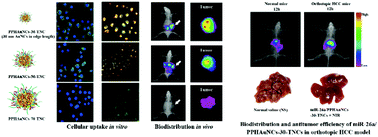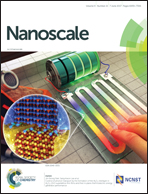Gold nanocages with dual modality for image-guided therapeutics†
Abstract
Numerous studies have demonstrated that microRNAs are very important in cancer development and progression. However, the complex relationship between the size of microRNA delivery systems, cellular uptake, biodistribution and therapeutic efficiency remains unclear. Herein, we have successfully constructed a series of differently-sized microRNA delivery systems, miR-26a-loaded, hyaluronic acid-modified, polyetherimide-conjugated PEGylated gold nanocage ternary nanocomplexes (PPHAuNCs-TNCs), which can be monitored optically by fluorescence and photoacoustic tomography imaging. We evaluated the effect of the particle size on the cellular uptake and biodistribution in the BEL-7402 cell line in vitro and in the subcutaneous and orthotopic hepatocellular carcinoma (HCC) mouse models. Our findings showed that the cellular uptake and biodistribution were optimal for cancer therapy with the PPHAuNCs-30-TNCs (30 nm AuNCs in edge length) in comparison with their 50 nm and 70 nm counterparts. PPHAuNCs-30-TNCs could accumulate in the liver for a longer time in an orthotopic mouse model of HCC than that in normal mice and could considerably restrain tumor growth in an orthotopic HCC mouse model under near-infrared radiation. This study may provide insightful information for developing novel non-viral microRNA vectors, and PPHAuNCs-30-TNCs have great potential for application in tumor diagnosis and cancer therapy in the future.



 Please wait while we load your content...
Please wait while we load your content...